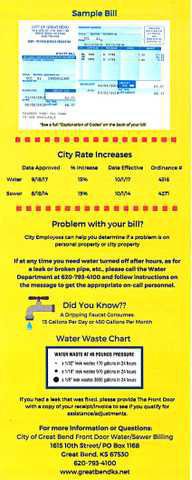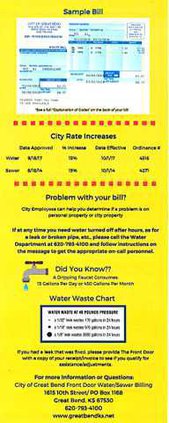Many Great Bend residents don’t understand how the city bills for water and sewer usage, an issue officials hope to address with a new pamphlet which is now available, City Clerk Shawna Schafer said, addressing the City Council Monday night.
She presented the new, full-color cards outlining the city’s water and sewer billing process to the council. The cards have been printed and are available at City Hall, 1209 Williams, and at the Front Door, 1615 10th.
As for water, the city is divided into four regions with meters in one region being read each week. Meters in the regions are not read in a specific week are estimated for that week, but will be read in a following month.
Water use is calculated weekly. Billing is done monthly to the nearest 1,000 gallons, Schafer said.
If the city estimates high the previous month, it will prorate a bill, Schafer said. If the estimate was low, the user will get billed for the additional that was not billed.
Sewer usage is based on a four-consecutive-month average of a user’s water usage, November through February, she said. This takes effect in October each year and the rate will stay the same for the entire year.
“This is a typical process used by the city and other cities,” Interim City Administrator George Kolb said.
“All the staff can do is read the meter,” Schafer said, responding to a concern from Councilman Brock McPherson who battled the Water Department over an excessively high bill. The water system from the meter to the house is the homeowner’s responsibility.
There are 6,500 water meters in the city, Public Works Director Charlie Suchy said. Starting five years ago, his department started to replace five percent of the meters each year.
Some of these are 30 years old or older. But Suchy said most of them are just as accurate as the newer ones.
However, “we investigate all complaints,” he said. “We’re trying to be as fair and accurate to the customers as possible.”








